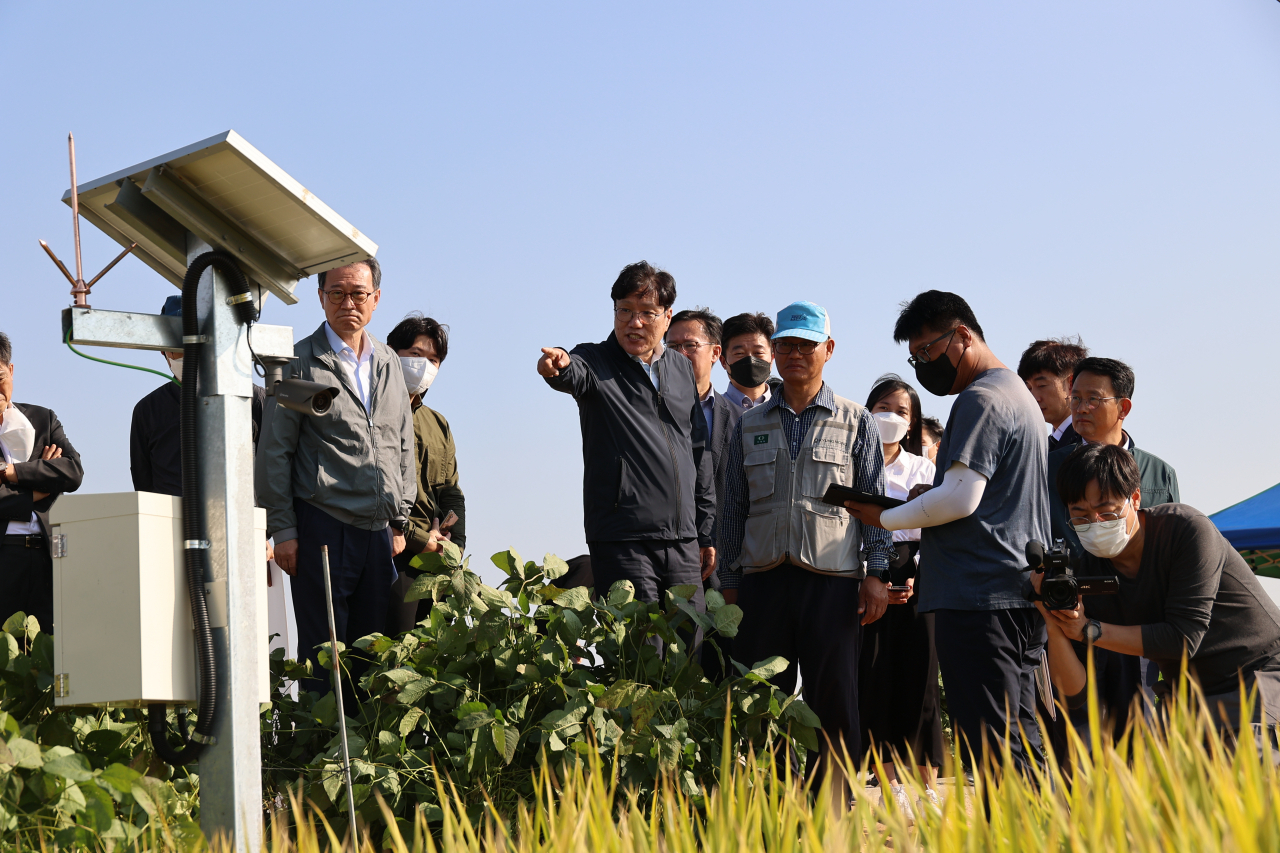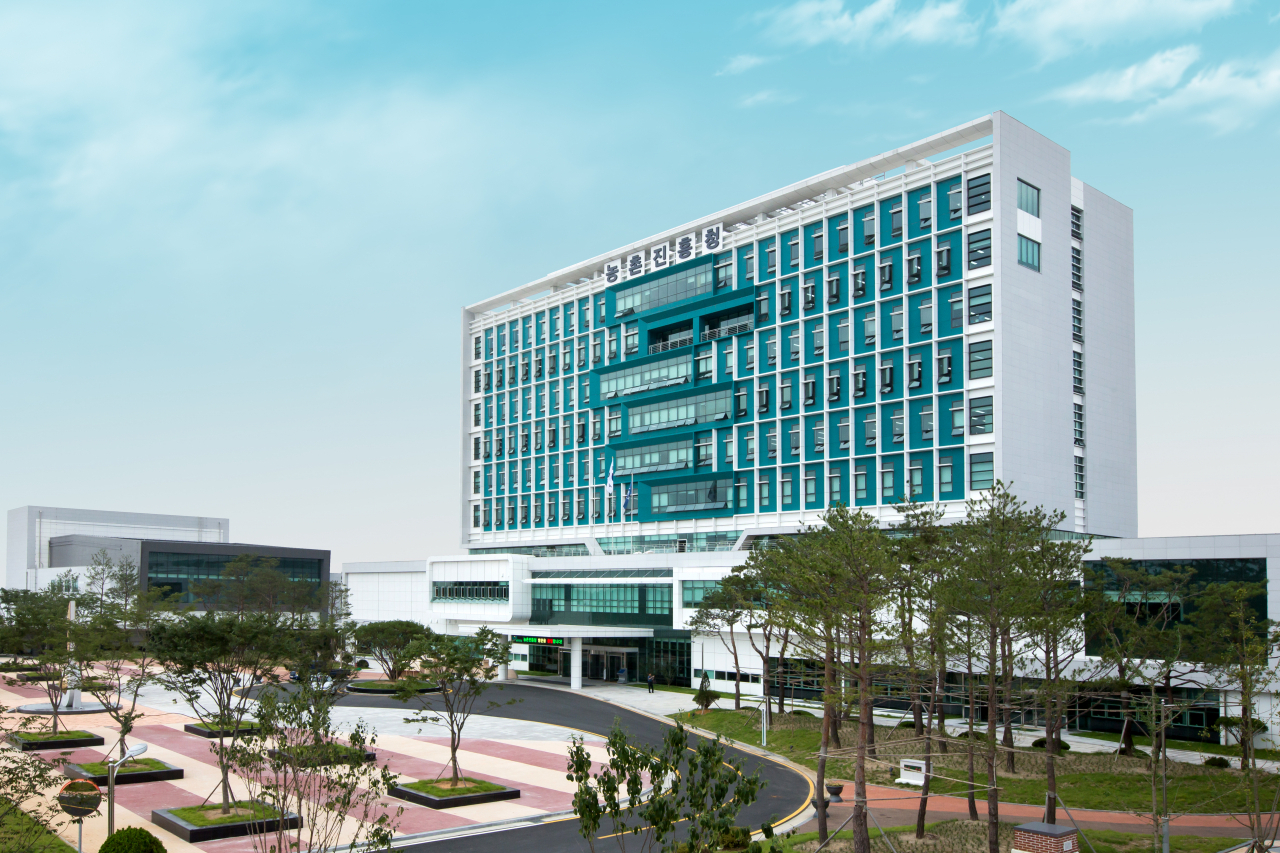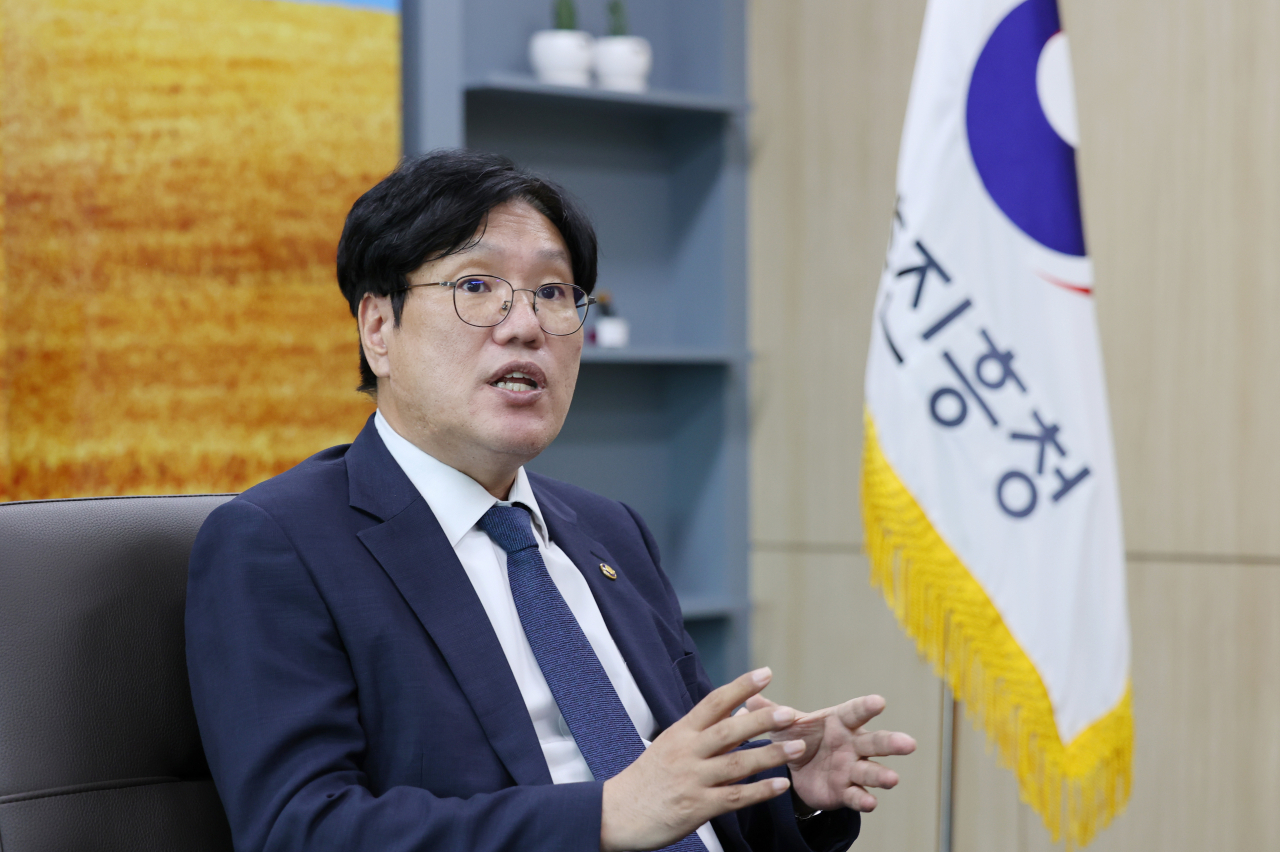 |
RDA Administrator Cho Chae-ho (center) inspects a rice paddy field in North Jeolla Province last year |
The term “RICE” expresses the Rural Development Administration’s roles and responsibilities: research and development, information, change and extension.
Administrator Cho Chae-ho launched the trustworthy RICE branding when he took office in May last year to get people to understand more about the agency, as the agency marked its 60th anniversary. He set a new vision and strategic goal to effectively carry out the RDA’s responsibilities for agriculture development by reflecting both current trends and people’s demands.
The RDA presents its vision for a “bright future for agriculture and happy rural community with agricultural science and technology.”
The RDA outlined four strategic goals to realize the vision: agriculture as a future growth industry, sustainable agriculture, vibrant rural communities and people’s happiness. Cho stressed in his New Year’s address that the RDA will actively conduct national-scale and focal projects with the four strategic goals.
The RDA also established an innovation system for agricultural R&D and technology dissemination and selected 10 core tasks for smart agriculture. It will spur the development of data-based smart agriculture and green biotechnology. The full use of rice flour is highly recommended to secure food sovereignty.
The RDA proceeds with technical support to maintain the stability of supply and demand of agricultural and livestock products and stabilize rural households by bringing production costs down. It is carrying out the full-scale promotion of fostering young farmers. With these efforts, the administration looks to address the extinction risk of rural areas. It also addresses current trade issues via customized technical support, to make South Korea a global pivotal state with a focus on leading cooperation within the international community.
 |
This photo shows the main building of the RDA located in Jeonju, the innovation city in North Jeolla Province. |
Carbon neutrality by 2050
Following the Paris Agreement in 2015 and UN Climate Action Summit 2019, carbon neutrality by 2050 has become a global mindset.
The Korean government set a national vision to achieve carbon neutrality by 2050 through energy transition and forestation, among other measures, as the Ministry of Agriculture, Food and Rural Affairs announced its “2050 Agri-Food Carbon Neutrality Promotion Strategy.”
To keep up with the government's strategies, the RDA published a related strategy early last year to disseminate agricultural technology for low carbon emissions. And to improve the accuracy of statistics on greenhouse gases, the RDA developed 48 emission and absorption factors for the agro-livestock sector. With the establishment of the platform for greenhouse gas statistics, it is able to inspect the implementation of carbon neutrality by municipal governments and provide related services.
The development of low-carbon agriculture technology has expanded. It has strengthened support to distribute and spread technologies and manage agricultural water for cultivating rice through simple irrigation and appropriate fertilizer usage. For low-carbon livestock management, it can improve the animal rearing system, develop low-methane feed and propagate the use of animal manure.
The technology also looks to strengthen the function of agricultural soil to sequester greenhouse gases and develop new greenhouse gas sinks, which also means the need to foster experts to demonstrate and disseminate the technology to the field.
New crops to respond to climate change
According to climate change scenario announced by the Korea Meteorological Administration, South Korea’s subtropical climate area will increase from 10.3 percent of its land to 18.2 percent in the 2030s, and further to 56 percent in the 2050s. By the 2090s, practically all of the country will lie within a subtropical climate. A subtropical climate is characterized by at least eight months with a mean temperature above 10 degrees Celsius.
Climate change has a great impact on fruit cultivation. In the 2070s, apple production is expected to be confined to only a small portion of Gangwon Province, and the areas of production for other fruits are expected to be reduced after 2050. Predictions show that the possible cultivation areas will be drastically reduced for apples (98 percent), pears (66 percent), peaches (64 percent) and grapes (59 percent).
Meanwhile, areas where subtropical fruits are cultivated will expand inland to southern coastal areas. Subtropical fruits previously had only been produced only on Jeju Island. But the areas will grow greatly for tangerines (1,244 percent) and sweet persimmon (673 percent), expanding inland and as far as coastal areas of Gangwon Province.
To adapt to climate change, the RDA has developed new varieties with high resistance to high temperatures. The administration has tested subtropical crops to assess their possibility of cultivation. So far, 35 total crops and 318 varieties have been developed.
Take “arisu” as an example. Arisu is a cultivar of domesticated apple that has been promoted by the RDA. It has excellent eating quality and quickly changes its peel color at high temperature. It contributes significantly to 68.2 percent of income growth compared to the Fuji apple.
As of last year, a total of 57 subtropical crops -- 38 vegetables and 19 fruits – had been introduced. Twenty-three manuals for the cultivation of 19 promising crops have already been published. The administration provides comprehensive support to stabilize the new crops into regional specialized crops through demonstrations, training for farmers and consultation.
Regional specialization
Regional agricultural policies must produce a competitive advantage at the national level as well as at the regional level. Therefore, the RDA is actively proceeding with the development of regional specialized crops to promote local agricultural development and improve competitiveness.
To this end, the administration is fostering regional research institutes and supporting local brands. To respond to the expansion of markets, the RDA is trying to improve the competitiveness of local agriculture. In 1992, the RDA established the Regional Specialized Crops Research Institute as a research and development hub.
Starting from Icheon, Gyeonggi Province, in 2016, RDA has proceeded with the development of representative rice varieties for Asan, South Chungcheong Province; the Incheon island of Ganghwado; and Gimpo, Gyeonggi Province -- with Yeoju, Gyeonggi Province, scheduled for later this year -- to raise their brand value and substitute for foreign rice varieties.
There are several best practices for the development of regional specialized new crop varieties and their dissemination. Fleshy plants for Gyeonggi Province, peppers for North Jeolla Province, kiwifruit for South Jeolla Province and flowering plants for South Gyeongsang Province are examples of some optimal matches. Seolhyang strawberries are already the representative specialized crop of South Chungcheong Province. And there’s no substitute for Icheon rice, which has been deemed better than foreign counterparts in quality.
New era in smart farming
The RDA is committed to research and development for agricultural machines with cutting-edge technology, autonomous tractors with artificial intelligence technology and the transition to smart farming in dryland farming.
Research is underway to advance the technology for uncrewed autonomous driving and to improve user convenience. An automated steering device is currently being developed to add high-accuracy autonomous navigation functions to the electric steering wheel.
With advanced camera technology based on AI, the autonomous tractor allows for a 360-degree view. It identifies obstacles in the field and continuously checks its position relative to a geofence, ensuring it is operating within bounds. The administration will also lead the establishment of an uncrewed farm work system through the development of agricultural robots, such as for weeding.
For smart dryland farming, agricultural machines are being developed by reflecting opinions from the field on sowing and harvesting. For rice and potatoes, yields can be monitored by location in real time.
The administration also strives to efficiently manage stable crop production and farm work using big data. The RDA is cooperating with the Ministry of Agriculture, Food and Rural Affairs, Ministry of Science and ICT and Ministry of Trade, Industry and Energy for the “Development of Digital Transformation Technologies for Open-Field Agriculture” project.
There is a growing need to disseminate smart agriculture technology due to Korea’s aging population and decline in labor force in rural areas. For autonomous tractors, prioritizing technology for localization is urgent because of the growth potential and strategic importance.
Supporting global food security
With its experience accumulated over the past 60 years, the RDA has been providing international aid to help developing countries achieve self-sufficiency and work proactively with the international community to resolve globally common issues via cooperation. The administration currently promotes agricultural technology cooperation with more than 120 research institutions in 52 countries in two development cooperation programs.
Korea Project on International Agriculture, or KOPIA, is disseminating country-specific specialized crops and innovative technologies in 23 countries to improve productivity and increased agricultural household income. The RDA has proceeded with the Food & Agriculture Cooperation Initiative with Asian, African and Central and South American countries to contribute to increasing food production and improving crops and livestock breeds, soil management and pest control.
With the help of KOPIA, potato cultivation and pest control technology were introduced to Kenya. Consequently, the agricultural household income has increased by 3.8 times for poultry farming and 1.6 times for potato cultivation. Vietnam's productivity of silkworm rearing and income have increased 60 percent and 30 percent, respectively, with the development of its own variety of mulberry and silkworm.
The RDA is now making a soil map for 13 Asian countries and establishing its soil information system. Farmers can easily utilize that soil information needed for crop cultivation. Along with the cooperation of the Africa Rice Center, the RDA has also developed 15 varieties of rice suitable for a tropical climate.
KOPIA programs for customized cross-border farming technologies to address poverty and rural challenges are appreciated by the international community and have been selected as an excellent case by the Organization for Economic Cooperation and Development.
Meanwhile, Ecuador succeeded in the production of seed potato technology from Korea which contributed to win the achievement award by UN for poverty eradication. The RDA's efforts will apparently result in securing food security of international community.
 |
RDA Administrator Cho Chae-ho |
Profile
Cho Chae-ho was inaugurated as the administrator of the Rural Development Administration in May 2022. He is a policy expert with 30 years of experience working at the Ministry of Agriculture Food and Rural Affairs.
Cho earned a bachelor’s in economics from Yonsei University and entered public service after passing the administrative examination in 1991. He also served at the Embassy of the Republic of Korea to the Kingdom of Belgium and the European Union and Permanent Mission to the North Atlantic Treaty Organization.
When Cho served as deputy minister at the Ministry of Agriculture Food and Rural Affairs in 2019, he established the efficient utilization plan of rural space. He put special efforts into stabilizing prices and the supply and demand of agricultural products. He also took the lead to amend the Establishment of the University of Agriculture and Fisheries Act. He served as president of Korea National University of Agriculture and Fisheries before his inauguration.
By Yang Jung-won (7toy@heraldcorp.com)







